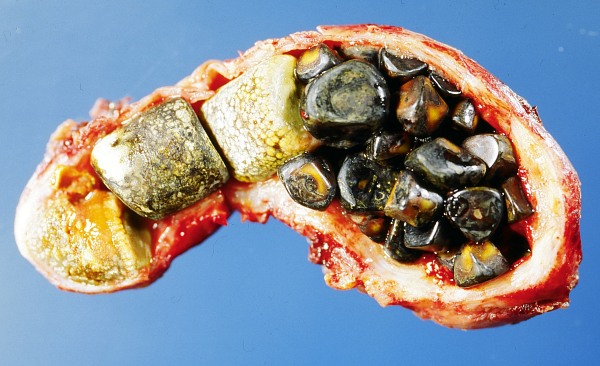Gallstone disease pathophysiology
| https://https://www.youtube.com/watch?v=UPw3ot1M_o0%7C350}} |
|
Gallstone disease Microchapters |
|
Diagnosis |
|---|
|
Treatment |
|
Surgery |
|
Case Studies |
|
Gallstone disease pathophysiology On the Web |
|
American Roentgen Ray Society Images of Gallstone disease pathophysiology |
|
Risk calculators and risk factors for Gallstone disease pathophysiology |
Editor-In-Chief: C. Michael Gibson, M.S., M.D. [1]; Associate Editor(s)-in-Chief: Hadeel Maksoud M.D.[2]
Overview
It has long been noted that gallbladder stone formation is associated with bile supersaturation, and this still remains the most common cause for gallstone formation.[1]
Pathophysiology

In general, gallstone disease can be caused by a lack of motility in the muscular wall of the gallbladder or excessive sphincter contraction, that prevents bile secretion. In this way the bile stagnates within the gallbladder and promotes the formation of stones. Rarely, the gallbladder may not properly fill with bile and so the bile is instead diverted from the gallbladder to the small bile duct which exacerbates the hypomotility and accelerates stone formation.[3][4] [5] The most common stone is usually formed from cholesterol. <
Pathogenesis of Specific Stones
Cholesterol Stones
Cholesterol is an important organic molecule that is needed for incorporation within cell membranes and to produce steroid hormones in the body. The quantity of cholesterol must be balanced internally, when cholesterol if in excess the only way in which the body can rid itself of it is through the formation of bile. The process of stone formation begins with the presence of biliary sludge.[3] Biliary sludge forms when antinucleating (crystallization-inhibiting) defence mechanisms fail to prevent cholesterol from precipitating or crystallizing in the bile whilst pronucleating (crystallization-promoting) mechanisms take the upper hand. Biliary sludge is a viscous mixture that consists of glycoproteins, calcium deposits and cholesterol crystals in the gallbladder. The sludge becomes hypersaturated and eventually stones form.[6][7]
Pigment Stones
Occasionally, gallstones are composed of bilirubin and are sometimes referred to as "pigment stones". Bilirubin is a byproduct of red blood cell breakdown. These stones are formed via two main pathways:
1. An infection of the biliary tract which predisposes to stone formation.
2. Bile, which is normally recycled after its secretion back from the small bowel and to the liver, may be enterohepatically cycled extensively. This may also cause the formation of a bilirubin stone. Pigment stones are seen more often in the Asian and African continents.[8]
Mixed Stones
There is a lack of evidence that supports a true pathology to explain how mixed stones are formed. However, there have been theories that include a combination of the mechanisms mentioned above.ref name="pmid12242178">Indar AA, Beckingham IJ (2002). "Acute cholecystitis". BMJ. 325 (7365): 639–43. PMC 1124163. PMID 12242178.</ref>
Associated Conditions
- Diabetes mellitus type 2
- Obesity
- Pregnancy
- Gallbladder cancer
- Gallbladder polyps
- Primary sclerosing cholangitis
- Porcelain gallbladder
- Rapid weight loss
- Constipation
- Eating fewer meals
- Low intake of:
On the other hand, wine and whole grain bread may decrease the risk of gallstones.[11]
Gross Pathology

On gross pathology, multiple small stones are commonly found or less commonly a solitary stone is seen. The smaller stones represent a higher morbidity since they can easily occlude the biliary tracts.[13]
Microscopic Pathology
On microscopic histopathological analysis, variable evidences of inflammation can be noted transmurally including neutrophils, which are characteristic in gallstone disease.[14]
References
- ↑ Wang HH, Portincasa P, Wang DQ (2008). "Molecular pathophysiology and physical chemistry of cholesterol gallstones". Front. Biosci. 13: 401–23. PMID 17981556.
- ↑ name="urlFile:Gallensteine 2006 03 28.JPG - Wikimedia Commons">"File:Gallensteine 2006 03 28.JPG - Wikimedia Commons".
- ↑ 3.0 3.1 Stinton LM, Shaffer EA (2012). "Epidemiology of gallbladder disease: cholelithiasis and cancer". Gut Liver. 6 (2): 172–87. doi:10.5009/gnl.2012.6.2.172. PMC 3343155. PMID 22570746.
- ↑ Indar AA, Beckingham IJ (2002). "Acute cholecystitis". BMJ. 325 (7365): 639–43. PMC 1124163. PMID 12242178.
- ↑ McPhee, Stephen (2014). Pathophysiology of disease : an introduction to clinical medicine. New York: McGraw-Hill Education Medical. ISBN 0071806008.
- ↑ Marschall HU, Einarsson C (2007). "Gallstone disease". J. Intern. Med. 261 (6): 529–42. doi:10.1111/j.1365-2796.2007.01783.x. PMID 17547709.
- ↑ Strasberg SM (2008). "Clinical practice. Acute calculous cholecystitis". N. Engl. J. Med. 358 (26): 2804–11. doi:10.1056/NEJMcp0800929. PMID 18579815.
- ↑ Myers RP, Shaffer EA, Beck PL (2002). "Gallbladder polyps: epidemiology, natural history and management". Can. J. Gastroenterol. 16 (3): 187–94. PMID 11930198.
- ↑ Lv J, Yu C, Guo Y, Bian Z, Yang L, Chen Y, Li S, Huang Y, Fu Y, He P, Tang A, Chen J, Chen Z, Qi L, Li L (2017). "Gallstone Disease and the Risk of Type 2 Diabetes". Sci Rep. 7 (1): 15853. doi:10.1038/s41598-017-14801-2. PMID 29158491.
- ↑ R.M. Ortega (1997). "Differences in diet and food habits between patients with gallstones and controls". Journal of the American College of Nutrition. 16: 88–95. Unknown parameter
|month=ignored (help); Unknown parameter|coauthors=ignored (help);|access-date=requires|url=(help) - ↑ European Journal Gastroenterology & Hepatology. 6: 585–593. 1995. Unknown parameter
|month=ignored (help);|access-date=requires|url=(help) - ↑ "File:Gallensteine 2006 03 28.JPG - Wikimedia Commons".
- ↑ Ansert, Sandra (2018). Textbook of diagnostic sonography. St. Louis, MO: Elsevier. ISBN 978-0323353755.
- ↑ Fisher, M. M. (1979). Gallstones. Boston, MA: Springer US. ISBN 1461570662.